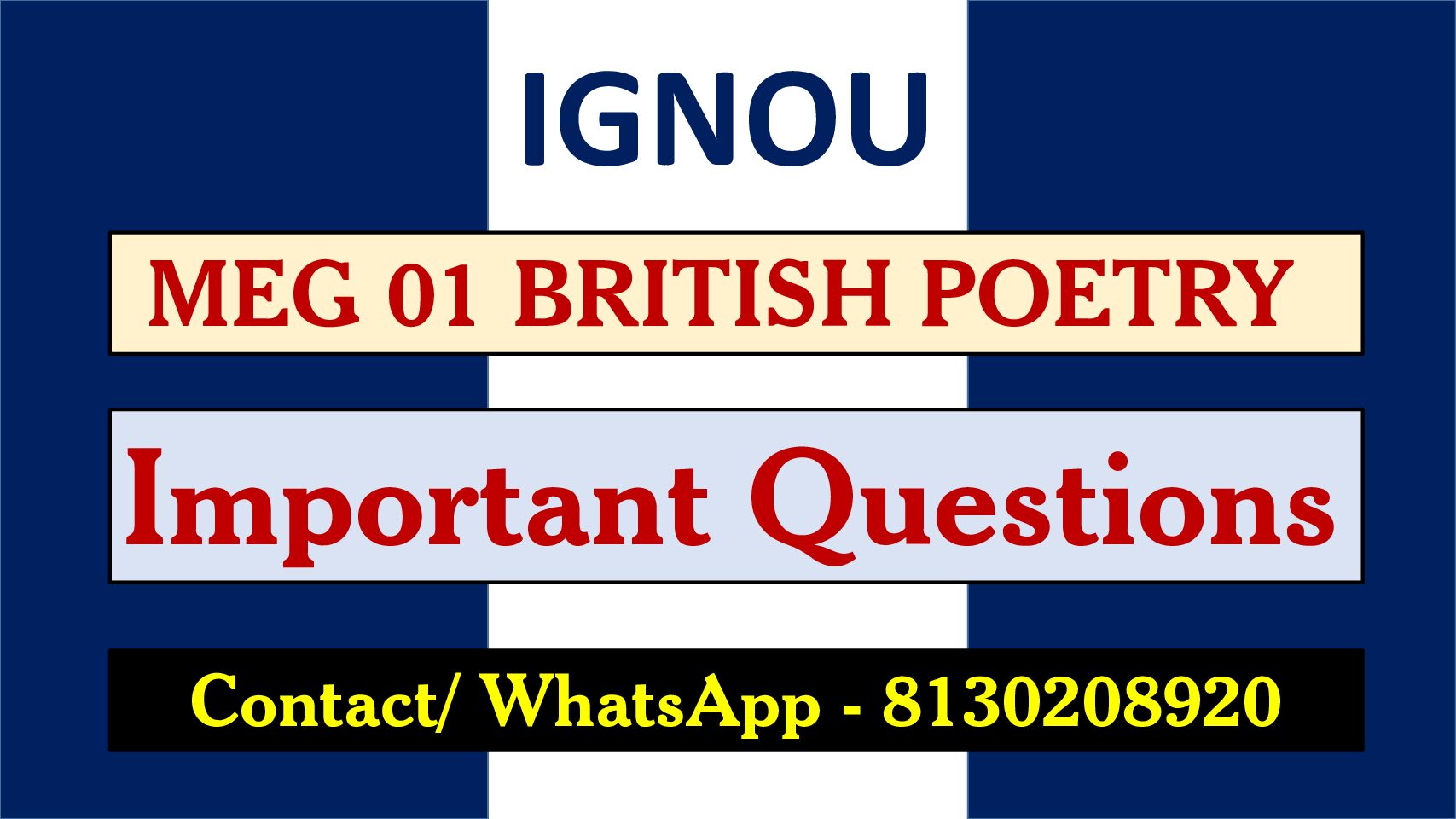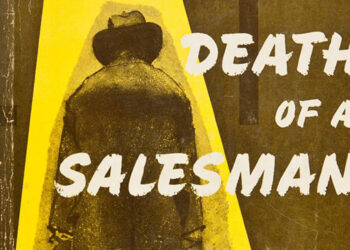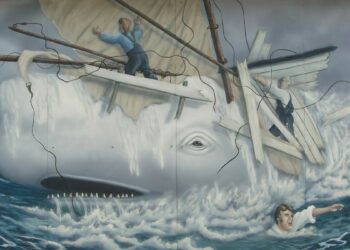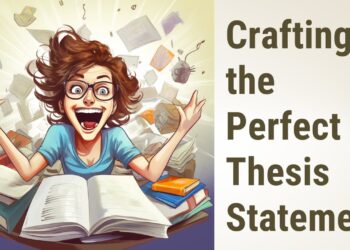IGNOU MEG 01 British Poetry Important Questions / Previous Years Solved Papers
IGNOU MEG 001 British Poetry Important Questions / Guess Papers for Exam Cognitive psychology is a branch of psychology focused on the study of mental processes. These processes include how people perceive, think, remember, and learn. Unlike behavioral psychology, which emphasizes observable behaviors, cognitive psychology delves into internal mental states and processes. The field emerged in the mid-20th century as researchers sought to understand the internal workings of the mind that were not adequately explained by behaviorism.
BUY PDF & Hardcopy
WhatsApp – 8130208920
IGNOU MEG 001 British Poetry Important Questions
How did the themes and styles of Anglo-Saxon poetry, such as “Beowulf,” differ from those of Middle English poetry, such as Chaucer’s “The Canterbury Tales”?
What are the defining characteristics of Elizabethan poetry, and how did poets like Edmund Spenser and Sir Philip Sidney contribute to its development?
How did the metaphysical poets, including John Donne and George Herbert, distinguish their work through themes, styles, and literary devices?
In what ways did the Cavalier poets, such as Robert Herrick and Richard Lovelace, respond to the political and social climate of 17th-century England?
How did John Milton’s “Paradise Lost” influence the development of epic poetry in English literature?
What role did nature and the sublime play in the poetry of the Romantic era, particularly in the works of William Wordsworth and Samuel Taylor Coleridge?
How did the themes of individualism and emotion in Romantic poetry differ from those of the preceding Neoclassical period?
What are the major themes and stylistic features of Victorian poetry, and how did poets like Alfred Lord Tennyson and Robert Browning reflect the concerns of their era?
How did Elizabeth Barrett Browning’s “Sonnets from the Portuguese” challenge traditional gender roles and expectations in Victorian poetry?
What innovations did the Pre-Raphaelite poets, such as Dante Gabriel Rossetti and Christina Rossetti, bring to British poetry in terms of form and subject matter?
How did the poetry of the fin de siècle, including works by Oscar Wilde and A.E. Housman, reflect the cultural and aesthetic shifts of the late 19th century?
In what ways did the war poetry of World War I, written by poets like Wilfred Owen and Siegfried Sassoon, address the horrors of war and the disillusionment of a generation?
How did T.S. Eliot’s “The Waste Land” revolutionize modernist poetry, and what themes and techniques did he employ to convey the fragmentation of post-war society?
What contributions did W.B. Yeats make to modernist poetry, and how did his work bridge the Romantic and modernist movements?
How did the poetry of the 20th-century British poets, such as W.H. Auden and Dylan Thomas, reflect the changing social and political landscape of their time?
What role did the Movement poets, including Philip Larkin and Kingsley Amis, play in reacting against modernist experimentation and returning to more traditional forms and themes?
How did postcolonial poets like Derek Walcott and Grace Nichols address issues of identity, displacement, and cultural heritage in their work?
What themes and stylistic innovations are evident in the poetry of contemporary British poets, such as Carol Ann Duffy and Simon Armitage?
IGNOU MEG Notes PDF 2024
British poetry has a rich and varied history, spanning over a millennium. Its evolution is marked by distinct periods, each contributing unique styles, themes, and voices to the canon. From the Old English epics to contemporary free verse, British poetry reflects the changing cultural, social, and political landscapes of the British Isles.
Old English Period (c. 450-1066)
The earliest phase of British poetry dates back to the Anglo-Saxon period. This era is epitomized by “Beowulf,” an epic poem that blends heroic narrative with mythic elements. Old English poetry often employed alliteration and a caesura (a pause) within lines. Themes of heroism, fate (wyrd), and the struggle against nature and enemies were prevalent. Other notable works include “The Seafarer” and “The Wanderer,” both of which explore themes of exile and the quest for meaning in a harsh world.
Middle English Period (1066-1500)
The Norman Conquest of 1066 brought significant linguistic and cultural changes, giving rise to Middle English poetry. Geoffrey Chaucer stands as the most prominent poet of this period, particularly with “The Canterbury Tales,” a collection of stories told by pilgrims on their way to Canterbury. This period saw the rise of chivalric romance, allegory, and religious themes, evident in works like “Sir Gawain and the Green Knight” and William Langland’s “Piers Plowman.” The shift from Old English to Middle English brought a broader range of subjects and a more diverse use of meter and rhyme.
The Renaissance (1500-1660)
The Renaissance was a time of rebirth in arts and letters, deeply influenced by classical antiquity. The introduction of the printing press allowed for broader dissemination of poetry. William Shakespeare, perhaps the most famous poet of this era, excelled in both sonnets and plays. His sonnets explored themes of love, time, beauty, and mortality. Edmund Spenser’s “The Faerie Queene” was an ambitious epic that fused allegory with contemporary politics and ethics. The Metaphysical poets, including John Donne and Andrew Marvell, brought a new intellectualism to poetry, characterized by wit, complex metaphors, and explorations of love and faith.
The Restoration and 18th Century (1660-1800)
Following the Renaissance, the Restoration period saw a shift towards satirical and didactic poetry. John Dryden and Alexander Pope were key figures, using heroic couplets to critique society and politics. Dryden’s “Absalom and Achitophel” and Pope’s “The Rape of the Lock” exemplify the era’s wit and formal precision. The 18th century also witnessed the rise of the Graveyard poets, such as Thomas Gray, whose “Elegy Written in a Country Churchyard” meditated on mortality and the passage of time. This period set the stage for the romantic reaction against the rationalism and formality of earlier poetry.
Romanticism (1798-1837)
The Romantic period marked a dramatic shift in British poetry, emphasizing emotion, nature, and individualism. William Wordsworth and Samuel Taylor Coleridge’s “Lyrical Ballads” is often credited with launching the movement. Wordsworth’s focus on everyday life and the sublime beauty of nature, as seen in “Lines Composed a Few Miles Above Tintern Abbey,” contrasted with Coleridge’s imaginative and supernatural themes in poems like “The Rime of the Ancient Mariner.” Other key Romantic poets include John Keats, whose odes reflect a profound aesthetic sensibility, and Lord Byron, whose narrative poems like “Don Juan” combined wit with a rebellious spirit.
Victorian Era (1837-1901)
The Victorian era was a time of great social change, and its poetry often reflected contemporary concerns with progress, industrialization, and morality. Alfred, Lord Tennyson, the Poet Laureate, captured the public imagination with works like “In Memoriam A.H.H.,” an elegy for his friend Arthur Hallam. Robert Browning and Elizabeth Barrett Browning explored themes of love, faith, and psychology through dramatic monologues and sonnets. Matthew Arnold’s “Dover Beach” poignantly expressed the era’s existential anxieties. The Pre-Raphaelite poets, including Dante Gabriel Rossetti and Christina Rossetti, revived medieval themes and emphasized vivid imagery and symbolism. IGNOU MEG 01 British Poetry Important Questions / Previous Years Solved Papers
VISIT – https://shop.senrig.in/

















